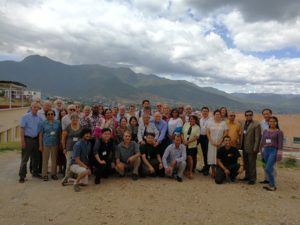In celebration of its 7th birthday, the International Network on Displacement and Resettlement hosted a very special conclave of involuntary resettlement and displacement specialists at the 2008 meeting of the Society for Applied Anthropology in Memphis, Tennessee, USA. March 25-28, 2008. (Info about annual meeting is on www.SfAA.net). The SfAA theme, “The Public Sphere and Engaged Scholarship: Opportunities and Challenges for Applied Anthropology” — was perfectly suited to examining the current “hot issues,” growing in importance worldwide, in the anthropology of displacement and resettlement.
Of all the international professional associations, the SfAA has offered a most hospitable harbor for scientific research, brainstorming, and dialogue on displacement issues. We feel our collective work on involuntary displacement is the area in which anthropology has made the single most influential impact on crafting formally adopted policies worldwide and changing many entrenched practices.
In consultation with Satish Kedia, a fellow resettlement researcher who was also the Program Chair of the 2008 SfAA meeting, Michael Cernea and Ted Downing asked a select group of global scholars working on involuntary displacement to make presentations on development-caused displacement and resettlement. We had multiple specialized sessions covering a broad spectrum of issues and an SfAA Plenary Session that combined the power of multiple sessions. Watch our news section for previews.
The special Plenary Session of the SfAA meetings were devoted to resettlement research and to the contribution and historical public role of anthropological research in this area. The format of the plenary session was deliberately oriented to also bring up USA issues linked to eminent domain displacement/resettlement in connection with the recent US Supreme Court decision on Kelo v New London.
The Plenary Session fostered a broad exchange of views about “where the world is at”“, “where the US is at”, and “where we are at” in the research and teaching of resettlement, and in identifying new, perhaps under-studied topics, which need to be studied to broaden our grasp and our engagement, both in theorizing resettlement and in influencing policies and actual projects and practice. The Plenary had two brief, launching presentations exploring: 1) Population Displacement: The International Dimension, Challenges and Tasks for Applied Anthropologists 2) Population Displacement: The National (US, Canada) Dimension, Eminent Domain, Research and Tasks for Applied Anthropologists.
After these, a panel commented/reinforced/contributed other ideas, and the large audience raised questions or argued alternatives. We welcomed researchers of population displacement caused by factors other than development projects (e.g. conflicts, wars, conservation parks, natural disasters, politically motivated population transfers, the environment, etc) and also specifically invited comparative sessions about mutually exchangeable concepts, common research methods, common or different policy approaches, among these displacement sub-types. An underlying goal was to and is to encourage a new generation of young scholars, teachers, researchers to engage in this “public sphere”, at a time when our average age is rising.
Last Updated ( Monday, 03 November 2008 )


